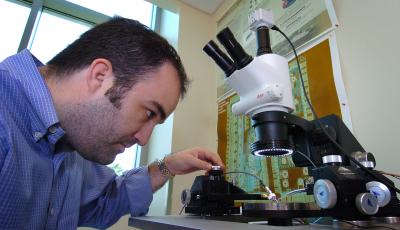Jenna Rickus, assistant professor of biomedical engineering at Purdue, has developed a "living electrode" coated with specially engineered neurons that, when stimulated, releases a neurotransmitter to inhibit epileptic seizures.
It's part of a larger collaboration focusing on creating a neuroprosthesis that dispenses a neurotransmitter called GABA and calms the brain once the onset of a seizure is detected. This work is a collaboration between Rickus and Pedro Irazoqui, also assistant professor of biomedical engineering at Purdue.
The technology is designed to prevent an epileptic "focal seizure," which starts in a specific area of the brain but can then quickly spread to the rest of the brain "like a brush fire," Irazoqui said.

"Once you find out where that focal area is, if you know the seizure is about to start you can suppress the seizure," he said.
Rickus and Irazoqui have shown that a certain amount of electrical current causes the neurons to release specific and controllable quantities of neurotransmitter.
"The idea is that by using an engineered cell to release a neurotransmitter, we have a drug pump, in essence, that automatically refills itself and that only impacts the part of the brain where the living electrode is implanted: the epileptic focus," Irazoqui said. "So you are not going to get the side effects that you get by washing the entire body in a particular pharmaceutical."
The system's high performance is made possible by simultaneously reducing power consumption and electronic interference. The researchers also calculated how well the signals are transmitted through tissue.
"We looked at the equivalent of the amount of skin that you have on your scalp, which is about 2 or 3 millimeters," Irazoqui said. "We have demonstrated that the transmitter does penetrate the thickness of tissue that would be required for this application."
The smaller the power consumption, the smaller the battery, which is critical for implantable devices. The battery in the Purdue device is about the size of a nickel. The signals are amplified, digitized and transmitted to the external receiver.




Comments